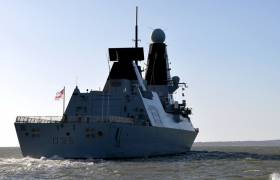Displaying items by tag: Daring UK Destoyer
Daring Dragon Destroyer Anchors During Volvo Cork Week
#DaringDragon - One of the UK’s most modern Royal Navy destroyers is also on a visit to Cork Harbour, having arrived yesterday afternoon, following that of a large auxiliary replenishment tanker-supply vessel, writes Jehan Ashmore.
The Type 45 ‘Daring’ Destroyer HMS Dragon (D35) displacing 8,000 tonnes is visiting as is the tanker RFA Fort Rosalie to coincide with Volvo Cork Week, hosted by the Royal Cork Yacht Club. In a new international services sailing competition, now part of Cork Week, Irish Defence Forces Team J19 yacht Joker 2 won the inaugural Beaufort Cup Fastnet Race out of 12 teams including those from the UK.
HMS Dragon which is on an anchorage call belongs to a class of six destroyers that are the backbone of the UK’s sea defence and on a worldwide basis. Primary roles are to hunt down on pirates, drug runners and submarines, in addition to defending the fleet from air attack and provide humanitarian aid after natural disasters.
RFA Fort Rosalie (A385), a Fort Class Solid Support Tanker of the Royal Auxiliary Fleet is berthed at Cobh’s deepwater berth, synonymous for cruise ships which this season sees 58 liners scheduled to call in 2016 bringing over 100,000 passengers and crew.
Likewise of RFA Fort Rosalie, the 152m long HMS Dragon is equipped with Phalanx systems, a key component in the arsenal of the navy. In addition is the principle anti-air missile, the Sea Viper which provides all-round defence. This is not just for the destroyer but for an entire naval task group and against all aerial threats some 70 miles away.
The Sea Viper can race towards its target at speeds in excess of Mach Four (over 3,000mph) using a series of tiny jets to manoeuvre, carrying out sharp turns at G forces no human could endure.
Note the ‘spinning egg’ atop the Type 45’s main mast which is a Sampson Radar that has a Combat Management System for long-range radar.
There is the Sylver missile-launching system on the destroyer's forecastle and Aster 15 and Aster 30 missiles with ranges up to 20 and 75 miles respectively.
Also mounted at the forecastle is the 4.5in main gun, found on all Royal Navy's destroyers and frigates, it is the most obvious provider of punch and firepower. The gun can fire up to two dozen high explosive shells, per minute, weighing more than 40kg (80lbs) at targets more than a dozen miles away.
The range can be extended to nearly 18 miles if special extended-range shells are used.





























































